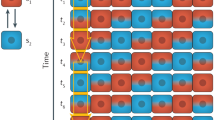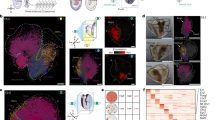Abstract
Modern studies of embryogenesis are increasingly quantitative, powered by rapid advances in imaging, sequencing and genome manipulation technologies. Deriving mechanistic insights from the complex datasets generated by these new tools requires systematic approaches for data-driven analysis of the underlying developmental processes. Here, we use data from our work on signal-dependent gene repression in the Drosophila embryo to illustrate how computational models can compactly summarize quantitative results of live imaging, chromatin immunoprecipitation and optogenetic perturbation experiments. The presented computational approach is ideally suited for integrating rapidly accumulating quantitative data and for guiding future studies of embryogenesis.
This is a preview of subscription content, access via your institution
Access options
Access Nature and 54 other Nature Portfolio journals
Get Nature+, our best-value online-access subscription
$29.99 / 30 days
cancel any time
Subscribe to this journal
Receive 12 digital issues and online access to articles
$99.00 per year
only $8.25 per issue
Buy this article
- Purchase on Springer Link
- Instant access to full article PDF
Prices may be subject to local taxes which are calculated during checkout


Similar content being viewed by others
Code availability
The code for the MCMC simulation, the processed experimental data used to estimate the parameters and code for generating ensemble predictions are available in ref. 28. The code is also available as Supplementary Software with this paper.
References
Wieschaus, E. & Nüsslein-Volhard, C. The Heidelberg screen for pattern mutants of Drosophila: a personal account. Annu. Rev. Cell Dev. Biol. 32, 1–46 (2016).
Karaiskos, N. et al. The Drosophila embryo at single-cell transcriptome resolution. Science 358, 194–199 (2017).
Wunderlich, Z. et al. Quantitative comparison of the anterior–posterior patterning system in the embryos of five Drosophila species. G3 9, 2171–2182 (2019).
Garcia, H. G. & Gregor, T. Live imaging of mRNA synthesis in Drosophila. Methods Mol. Biol. 1649, 349–357 (2018).
Patel, A. L. et al. Capicua is a fast-acting transcriptional brake. Curr. Biol. https://doi.org/10.1016/j.cub.2021.05.061 (2021).
Chen, S. Y. et al. Optogenetic control reveals differential promoter interpretation of transcription factor nuclear translocation dynamics. Cell Syst. 11, 336–353 (2020).
Blum, Y. et al. Temporal perturbation of ERK dynamics reveals network architecture of FGF2/MAPK signaling. Mol. Syst. Biol. 15, e8947 (2019).
Guignard, L. et al. Contact area–dependent cell communication and the morphological invariance of ascidian embryogenesis. Science 369, eaar5663 (2020).
Ngo, K. A. et al. Dissecting the regulatory strategies of NF-κB RelA target genes in the inflammatory response reveals differential transactivation logics. Cell Rep. 30, 2758–2775 (2020).
Eck, E. et al. Quantitative dissection of transcription in development yields evidence for transcription-factor-driven chromatin accessibility. eLife 9, e56429 (2020).
Hwang, D. et al. A data integration methodology for systems biology. Proc. Natl Acad. Sci. USA 102, 17296–17301 (2005).
Frenklach, M. Transforming data into knowledge–process informatics for combustion chemistry. Proc. Combustion Institute 31, 125–140 (2007).
Ajuria, L. et al. Capicua DNA-binding sites are general response elements for RTK signaling in Drosophila. Development 138, 915–924 (2011).
Grimm, O. et al. Torso RTK controls Capicua degradation by changing its subcellular localization. Development 139, 3962–3968 (2012).
Patel, A. L. & Shvartsman, S. Y. Outstanding questions in developmental ERK signaling. Development 145, dev143818 (2018).
Goyal, Y., Schupbach, T. & Shvartsman, S. Y. A quantitative model of developmental RTK signaling. Dev. Biol. 442, 80–86 (2018).
Keenan, S. E. et al. Rapid dynamics of signal-dependent transcriptional repression by Capicua. Dev. Cell 52, 794–801 (2020).
Johnson, H. E. et al. The spatiotemporal limits of developmental ERK signaling. Dev. Cell 40, 185–192 (2017).
Patel, A. L. et al. Optimizing photoswitchable MEK. Proc. Natl Acad. Sci. USA 116, 25756–25763 (2019).
Dutta, S., Djabrayan, N. J.-V., Torquato, S., Shvartsman, S. Y. & Krajnc, M. Self-similar dynamics of nuclear packing in the early Drosophila embryo. Biophys. J. 117, 743–750 (2019).
Schuh, L. et al. Gene networks with transcriptional bursting recapitulate rare transient coordinated high expression states in cancer. Cell Syst. 10, 363–378 (2020).
Raj, A. & van Oudenaarden, A. Nature, nurture, or chance: stochastic gene expression and its consequences. Cell 135, 216–226 (2008).
Thattai, M. & van Oudenaarden, A. Intrinsic noise in gene regulatory networks. Proc. Natl Acad. Sci. USA 98, 8614–8619 (2001).
Brooks, S. Handbook of Markov Chain Monte Carlo (CRC Press, 2011).
McFann, S., Dutta, S., Toettcher, J. E. & Shvartsman, S. Y. Temporal integration of inductive cues on the way to gastrulation. Proc. Natl Acad. Sci. USA 118, e2102691118 (2021).
Goyal, Y. et al. Parallel imaging of Drosophila embryos for quantitative analysis of genetic perturbations of the Ras pathway. Dis. Model. Mech. 10, 923–929 (2017).
Gregor, T., Wieschaus, E. F., McGregor, A. P., Bialek, W. & Tank, D. W. Stability and nuclear dynamics of the bicoid morphogen gradient. Cell 130, 141–152 (2007).
Dutta, S., Patel, A. L., Keenan, S. E. & Shvartsman, S. Y. Model of terminal patterning in Drosophila (Zenodo, 2021); https://doi.org/10.5281/zenodo.5031399
Acknowledgements
We thank M. Frenklach, E. Wieschaus, T. Schüpbach and all members of the Shvartsman laboratory for helpful discussions. We thank L. Reading-Ikkanda for graphic design of the figures. We thank G. Laevsky and the Molecular Biology Core Confocal Microscopy Facility for imaging support. We thank L. Yang for the enzyme-linked immunosorbent assay experiment. We thank N. J.-V. Djabrayan and G. Jimenez for the synthetic reporter CZC. We thank the Lewis Sigler Institute of Integrative Genomics for computational resources. The research was supported by the NIH (HD085870 grant). The funding agencies had no role in study design, data collection and analysis, decision to publish or preparation of the manuscript.
Author information
Authors and Affiliations
Contributions
S.E.K. and A.L.P. carried out all the experiments. S.E.K., S.D. and A.L.P. analyzed the data. S.Y.S., S.D. and S.E.K. designed the model. S.D. implemented the model and performed the simulations. S.D., A.L.P., S.E.K. and S.Y.S. wrote the manuscript
Corresponding author
Ethics declarations
Competing interests
The authors declare no competing interests.
Additional information
Peer review information Nature Computational Science thanks the anonymous reviewers for their contribution to the peer review of this work. Handling editor: Ananya Rastogi, in collaboration with the Nature Computational Science team.
Publisher’s note Springer Nature remains neutral with regard to jurisdictional claims in published maps and institutional affiliations.
Supplementary information
Supplementary Information
Supplementary Figs. 1–8 and Table 1.
Supplementary Software
A set of codes that demonstrate how we learn parameters from the existing dataset from multi-scale experiments in a gene regulatory network in the terminal patterning system of the Drosophila (fruit fly) embryo and make quantitative predictions as described in the paper.
Source data
Source Data Fig. 1
For the simulation results, data from all 1,000 experiments are given. Each row represents the time point mentioned in the left-most column, and all other columns represent the simulation output from each parameter set. For the experiment, the fluorescence intensity of nuclear Cic for all the nuclei is given. These are background-subtracted, averaged and normalized as described in the paper to obtain the data in Fig. 1c. In each row, the first entry is the time point followed by the fluorescence intensity of all the nuclei, followed by zeroes when the number of nuclei is less than the number of columns.
Source Data Fig. 2
For Fig. 2a–d, all the parameters obtained from MCMC simulation are given. The columns represent individual parameters, and each row represents an individual parameter. In Fig. 2e–g, ‘full simulation’ refers to the same data as for Fig. 1e (top). Data for all the perturbed simulations are given. Each row represents the time point mentioned in the left-most column, and all other columns represent the simulation output from each parameter set.
Rights and permissions
About this article
Cite this article
Dutta, S., Patel, A.L., Keenan, S.E. et al. From complex datasets to predictive models of embryonic development. Nat Comput Sci 1, 516–520 (2021). https://doi.org/10.1038/s43588-021-00110-2
Received:
Accepted:
Published:
Issue Date:
DOI: https://doi.org/10.1038/s43588-021-00110-2



